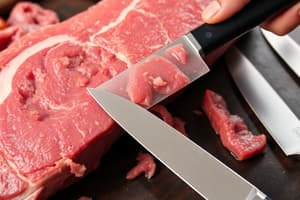Podcast
Questions and Answers
What distinguishes a localized condition from a generalized condition in slaughter animals?
What distinguishes a localized condition from a generalized condition in slaughter animals?
- Localized conditions are always fatal.
- Localized conditions affect multiple organs at once.
- Localized conditions are confined to a specific area or organ. (correct)
- Localized conditions result in systemic inflammation.
Which of the following signs indicates a generalized disease in slaughter animals?
Which of the following signs indicates a generalized disease in slaughter animals?
- Generalized inflammation of lymph nodes (correct)
- Slight swelling of a single joint
- Localized abscesses in the liver
- Minor digestive upset
Which type of lesion would likely require more severe judgment during meat inspection?
Which type of lesion would likely require more severe judgment during meat inspection?
- Generalized lesions in multiple organs (correct)
- Subtle lesions in the digestive tract
- Dermal lesions in a single area
- Localized lesions
What is a common pathological symptom in generalized conditions found during the inspection of carcasses?
What is a common pathological symptom in generalized conditions found during the inspection of carcasses?
What distinguishes an acute condition from a chronic condition?
What distinguishes an acute condition from a chronic condition?
What assessment is crucial for cases showing systemic lesions?
What assessment is crucial for cases showing systemic lesions?
What is an example of a condition that occurs between acute and chronic stages?
What is an example of a condition that occurs between acute and chronic stages?
What do adhesions in chronic conditions typically replace?
What do adhesions in chronic conditions typically replace?
What is the primary aim of meat inspection procedures?
What is the primary aim of meat inspection procedures?
During what stage is ante-mortem inspection conducted?
During what stage is ante-mortem inspection conducted?
What phase follows ante-mortem inspection in meat inspection procedures?
What phase follows ante-mortem inspection in meat inspection procedures?
What complication arises in cases of subchronic and peracute stages?
What complication arises in cases of subchronic and peracute stages?
Flashcards are hidden until you start studying
Study Notes
Suspecting Disease in Slaughter Animals
- Signs of disease include off-fed appearance, listlessness, fever, weakness, labored breathing, nasal discharge, and diarrhea.
- Localized lesions are restricted to specific areas or organs, while generalized conditions affect the circulatory or lymphatic systems.
- Generalized diseases require a more severe judgment during inspection due to broader implications.
Generalized Conditions
- Symptoms of generalized disease include inflammation of lymph nodes, joint inflammation, lesions in organs like the liver, spleen, kidneys, heart, and presence of multiple abscesses throughout the carcass.
- Abscesses in the liver can vary in size and are randomly distributed across all lobes.
Acute versus Chronic Conditions
- Acute conditions develop over days, chronic conditions progress over weeks, months, or years.
- Subacute conditions fall between acute and chronic, presenting inflammation in organs, enlarged lymph nodes, and petechial hemorrhages.
- Acute stages are often linked to generalized disease; systemic lesions need individual assessment for significance to vital organs.
Chronic Conditions
- Chronic inflammation may lead to adhesions, necrotic tissue, or abscesses; judgment in these cases tends to be less severe.
- Affected portions may be removed, and the rest of the carcass may not be condemned.
- Complications can arise in subchronic and peracute stages, particularly with necrotic tissue linked to prior infections.
Objectives of Meat Inspection
- Ensure that only healthy animals are slaughtered for human consumption.
- Confirm meat is disease-free, wholesome, and safe for human health.
Meat Inspection Procedures
- Antemortem inspection: Assessing live animals before slaughter to identify abnormalities.
- Postmortem inspection: Evaluating carcasses and meat post-slaughter, following stunning to cooling processes.
Studying That Suits You
Use AI to generate personalized quizzes and flashcards to suit your learning preferences.




